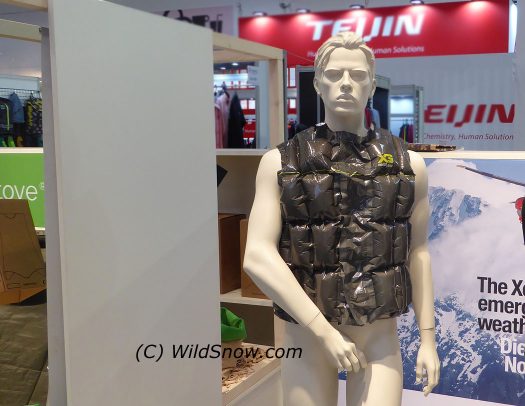When I’ve got an hour I always head to the ISPO New section of the show. I look for one thing there that deserves a blog post of its own. Found it. Zerogear. Just the name makes this core weight weenie want one!
(NOTE: We’re not certain this product is actually in retail, attempts to contact the company have been unsuccessful and their shopping cart appears to be a lash-up, so I’ll publish this post assuming you can purchase the product — though that may not be the case…)

We’ve seen air insulated clothing before, but I can’t remember anything clearly purposed for emergency use. Launched at this winter’s Outdoor Retailer and ISPO, Xerogear vest weighs 57 grams. It’s designed to go where you go, no matter what.
Those of you who travel light in the mountains, are you ever concerned about being involved in an accident and not having enough clothing to go around? Or are you embarking on mega tours in deep wilderness and looking at possible unplanned overnights and such? What you need for your kit is an emergency insulation layer that weighs almost nothing. I’m nearly certain these guys have figured out something that’ll work; simply a blow-up vest made of super-thin plastic, reflective on the inside. Weight, 57 grams (2 ounces).
Other gas insulated clothing has come and gone over the years, some still around. Difference here is this being an uber-light layer strictly for emergencies — or to prevent a semi desperate situation from becoming emergent.
A couple of concerns. Clearly, this is an emergency-only layer and is probably somewhat fragile when it comes to punctures or campfire damage. Likely best used under a conventional shell layer. In terms of engineering, larger air cells such as these can be prone to convection currents that somewhat compromise insulation benefits. Just sleep on an air mattress without insulation fill and you know this is true. So we’ll need to test this to see exactly how effective it really is.
Price is right at around 10.00 USD, buy one for your car, one for your backpack, and one to put in your SAR stash. Heck, keep a few at home next to your canned food to satisfy your inner prepper!
Check out Xerogear’s website. Tells the whole (brief) story (warning, slow loading site). Or, below is their PR, lightly edited. Know this was originally a Kickstarter from a group of guys in the U.S., and appears to have received a modicum of coverage. Presently, it appears they have a product they can actually retail. We’ll be checking on this thoroughly as we progress. Testing to comments for certain.
PR: The XeroVest is a highly portable, inflatable, air-insulated emergency garment. Weighing only 2 oz. (57g), the vest is made up of a network of cross-connected cells which are inflated through a simple one-way mouthpiece on the vest’s collar. Inflating the vest creates a warm, insulating layer of trapped air, conforming to the shape of the wearer (Wildsnow note, filling with warm air from you lungs is a nice touch, this could be done by a rescuer for an instant touch of heat). This insulates the wearer’s body core while allowing moist air to escape through the vest’s integrated vent holes. Interior surface of the vest is mirrored and thermally reflective.
WildSnow.com publisher emeritus and founder Lou (Louis Dawson) has a 50+ years career in climbing, backcountry skiing and ski mountaineering. He was the first person in history to ski down all 54 Colorado 14,000-foot peaks, has authored numerous books about about backcountry skiing, and has skied from the summit of Denali in Alaska, North America’s highest mountain.
